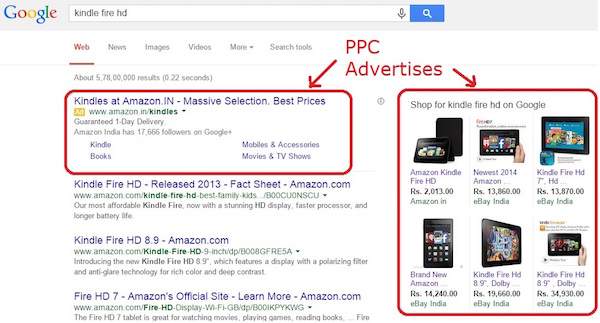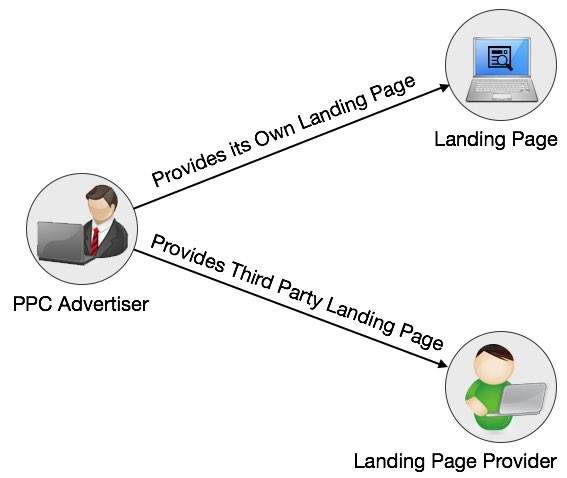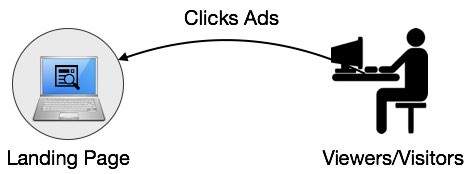PPC - Introduction
We have the Internet that provides a huge platform for advertising products and services online. Advertisers around the world have shown a keen interest in making good use of the Internet that is omnipresent these days to market various products and speed up their business activities by reaching out to numerous users.You might be aware of the conventional methods of push marketing that involves the use of brochures, television ads, radio ads, banners, bills, balloons, etc. where people are driven to hear, listen, and view the product or service they can get.
Quite contrary to the traditional model, the recent methods of internet marketing involve innovative techniques to catch more eyeballs and pull online traffic to visit, listen, view, or buy a product or a service that is on offer. It is done through a model that is now being widely regarded as Pay Per Click (PPC). It is a successful model for internet advertising that directs online traffic to particular websites, where the advertisers pay the publishers a certain amount when their ad is clicked.
Here, in this introductory chapter, we will provide an overview of PPC as a concept and explain the role of its entities involved in the entire workflow of PPC advertising.
About PPC Ad
PPC stands for Page Per Click. It is an internet marketing model where the advertisers use the publishers’ website to market their products or services through ads. The publisher gets paid by the particular advertisers when a user clicks on their ads. It is a pull-type internet marketing of buying user visits to a site.
Search Engine Advertising
One of the most popular forms of PPC marketing is Search Engine Advertising (SEA). It allows advertisers to bid for placement of ads in the search engine’s sponsored link, when a user searches for a keyword that is relevant to a product or a service.Whenever a user clicks on an ad, the link directs the user to the product’s website. At the same time, the product or service provider needs to pay some amount to the search engine, such as Google.
Behind every successful PPC campaign lies a catchy ad that can attract the attention of online users. Advertisers focus on the following aspects while creating an online ad:
- Research for effective keywords related to a product or a service
- Choose the right keywords
- Group the keywords relevantly
- Arrange the keywords to create an advertise
Google AdWords is an example of a popular advertising system. It facilitates businesses to publish ads on Google’s search engine.
Entities Involved in PPC Advertising
The following entities are involved in PPC Advertising:- Product or Service Seller
- PPC Advertiser
- Landing Page Provider
- Landing Page
- Viewer or the Visitor




Workflow of a PPC Ad
The workflow of a PPC ad is as follows:- First of all, the advertiser creates an online account and loads her account with some money – say Rs 5000. Note that some organizations allocate their PPC budgets in hundreds, thousands, or even millions of rupees per month.
- The advertiser creates a small text ad. In some cases, a PPC ad can include images.
- The advertiser specifies a list of keywords associated with the ad.
- The advertiser determines how much she is ready to pay each time someone clicks on the ad.
- On the buyer’s side, a user visits the search engine – say Google.com, enters one of the keywords or keyword phrases - say “Kindle Paper white” and clicks the Search button.
- The search engine finds the matching ads and places them on the results page.
- If a user clicks on the ad, she is taken to the advertiser's website, and the advertiser is charged for the click.
History of PPC
PPC ads have been in existence over a decade now. The term PPC came into existence during the year 1990 when organizations started conducting their business on the Internet. One of the companies that pioneered the concept was goto.com. Yahoo took it over in 2003.When Google launched its AdWords solution for PPC marketing, heavy activities started in the domain of PPC. In addition to Google, a number of search engines such as Yahoo, Bing, 7Search, ABCSearch, and Findology provide PPC ad hosting.
PPC Terminology
Given below is a list of the terms frequently used in PPC advertising followed by a short description of the terms. You should be thorough with these terms before proceeding further.| Ad group | It is a collection of relevant keywords under one name. Maximum 20,000 keywords can be added into an Ad Group. |
| Ad Network | An Ad Network is an online business that specializes in matching up of advertisers to the websites looking to host the ad. Ad networks work as brokers for both suppliers (sites with content that can host ads, for example, tutorialspoint.com) and buyers (the advertisers). An ad network relieves the websites from having to set up and invest in their own ad servers and tracking software. |
| Ad Position | Ad position is the order in which an ad is displayed on a webpage. For example, ad position "1" means the ad is displayed first on the webpage. |
| Ad Rank | It is a value used to determine the Ad Proposition. |
| Call-To-Action (CTA) | This is a marketing term used for the action you want the website visitor to take. |
| Campaign | It is a series of relevant ad groups. |
| Click-Through-Rate (CTR) | It is a metric showing how often a visitor clicks your ad after seeing it. It can be defined as the number of clicks per thousand impressions. CTR contributes to Ad Rank. |
| Conversion | Conversion is the action the user wants when he clicks on an ad. It occurs when a visitor takes action. For example, the user makes purchases, signs ups, submits enquiry forms, views a page, or downloads, depending on the program's goals. |
| Conversion Rate | It is the measurement of the success of a paid campaign. It is
measured by the number of potential visitors performing any of the
desired actions such as buying a product, filling a form, etc. For example, if there are 100 visitors to a particular webpage via a PPC ad, and three of those 100 visitors buy the product the website sells, then the conversion rate for that particular ad is three percent. The larger the conversion rate, the more successful the website is. |
| Cost Per Action or Cost Per Acquisition (CPA) |
It is the amount you pay for every lead, sign-up, or purchases. |
| Cost Per Click (CPC) | It implies the amount you pay for every single click on your ads. |
| Cost Per Mille (CPM) | It is the amount paid for every thousand views of the PPC ad. |
| Destination URL | It is where you want the user to land when he clicks on the ad. |
| Display URL | It is the name of a page of the website. |
| Geo-targeting | Delivery of ads to a particular geographic location of the users. It allows the advertisers to choose specific locations where they wish to show their ads. |
| Impression | In the context of online advertising, it is a measure of the number of times an ad is seen irrespective of clicking on it. Each time the ad displays, it is counted as one impression. |
| Keyword | It is a search query made by a user. A word or a phrase of words entered in the search box by the user. The search engine matches your keywords and gives you relevant results on the Search Engine Result Page (SERP). |
| Landing Page | It is any standalone webpage distinct from the main website on which the visitor lands. |
| Negative Keywords | They are the ones for which you do not want your ad to appear. |
| PPC Bid | It is the maximum amount of fees an advertiser is ready to pay for a click. |
| Prospect | Prospect is a potential user who can buy a product/service being advertised. |
| Quality Score | It is a dynamic metrics assigned to each of your keywords and ads. It determines the quality of your keyword, ad, and the landing page. High quality score boosts the ad rank. |
| Search Engine Result Page (SERP) | The page that lists the results returned by the search engine in response to a user query. |
| Split Testing | It is a classic method of testing an ad to determine the effectiveness of a PPC ad. It compares two versions of an ad that are identical except for one specific difference of a word or an image. |

No comments:
Post a Comment